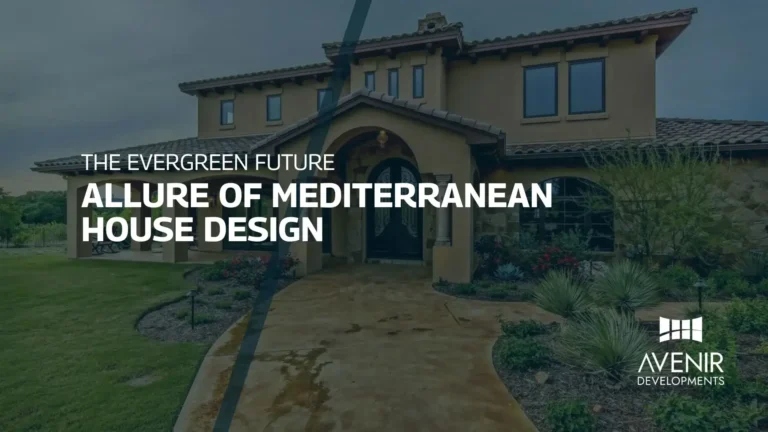Have you ever dreamt of escaping to a sun-drenched villa overlooking a sparkling coastline? The allure of Mediterranean house design lies in its ability to capture the essence of this idyllic lifestyle and translate it into a comfortable and aesthetically pleasing home. In this blog post, we at Avenir Developments, a leading architecture and construction firm based in Islamabad, Pakistan, with extensive experience in international design, will delve deep into the world of Mediterranean architecture.
We’ll explore its rich history, captivating characteristics, modern adaptations, and answer all your burning questions about building a Mediterranean dream home.
A Journey Through Time: Unveiling the History and Evolution of Mediterranean Architecture
The captivating allure of Mediterranean house design is a product of centuries of cultural exchange and adaptation. Its story begins along the shores of the Mediterranean Sea, encompassing countries like Greece, Italy, Spain, Portugal, and Morocco. Each region infused the style with its distinct architectural heritage, resulting in a rich tapestry of influences.
Early Influences (Ancient Greece and Rome)
The earliest roots of Mediterranean architecture can be traced back to ancient Greece and Rome. Greek temples, with their emphasis on symmetry, proportion, and colonnades, laid the groundwork for the classical aesthetic that permeates the style. Romans, known for their engineering prowess, introduced elements like arches, domes, and courtyards, which continue to define Mediterranean homes today.
Medieval Metamorphosis (Moorish and Spanish Fusion)
The arrival of the Moors in the Iberian Peninsula during the 8th century marked a significant turning point. Moorish architecture, with its intricate tilework, decorative plasterwork, and focus on interior courtyards (patios), blended beautifully with the Romanesque style prevalent in Spain. This fusion gave birth to what we now recognize as the quintessential Spanish hacienda.
The Rise of the Italian Renaissance
The 14th-century Italian Renaissance revived interest in classical forms and proportions. This period saw the construction of grand villas featuring symmetrical layouts, central courtyards, and loggias (open galleries). These elements became hallmarks of the Italianate style, a sub-category within the broader Mediterranean architectural spectrum.
Global Inspiration and Modern Adaptations
Over the centuries, Mediterranean architecture spread beyond its coastal origins, influencing colonial architecture in the Americas and other parts of the world. Today, Mediterranean house design continues to evolve, incorporating modern amenities and materials while retaining its core characteristics.
A Modern Renaissance: The Enduring Appeal of Mediterranean Architecture in Pakistan and Around the World
The charm of Mediterranean house design transcends geographical boundaries. In recent years, there has been a surge in popularity of this architectural style in Pakistan and around the world. This can be attributed to several factors:
Climate Compatibility
The core elements of Mediterranean architecture – thick walls, terracotta roofs, and shaded courtyards – are particularly well-suited for warm and sunny climates like those prevalent in many parts of Pakistan. These features help to regulate indoor temperatures, creating a naturally cool and comfortable living environment.
Embrace of Outdoor Living
Mediterranean homes seamlessly integrate indoor and outdoor spaces. Patios, balconies, and terraces encourage residents to spend time outdoors, fostering a connection with nature and a relaxed lifestyle. This resonates deeply with modern homeowners seeking to create a haven for entertaining and relaxation.
Aesthetic Versatility
Mediterranean architecture offers a spectrum of styles, from the rustic simplicity of Spanish haciendas to the grandeur of Italianate villas. This allows for customization to suit individual preferences and budget considerations. Modern interpretations often blend traditional elements with contemporary materials and clean lines, resulting in a timeless elegance.
Cultural Connection
For some homeowners in Pakistan, particularly those with ancestral ties to the region, Mediterranean architecture evokes a sense of nostalgia and cultural connection. It allows them to incorporate elements of their heritage into their living spaces.
Examples of Modern Mediterranean Architecture in Pakistan
While still a niche market, Mediterranean-inspired house designs are becoming increasingly popular in Pakistan. Here are a few examples:
- Luxury villas in Bahria Town Karachi: Several prominent developers are incorporating elements like terracotta roofs, arched doorways, and landscaped courtyards into their high-end villa projects.
- Gated communities in Islamabad: Some gated communities in Islamabad are showcasing modern takes on the Mediterranean aesthetic, with a focus on open floor plans and integration with outdoor spaces.
Looking to the Future
As Pakistan’s construction industry continues to evolve, we can expect to see more innovative and sustainable adaptations of Mediterranean architecture. The use of locally sourced materials and energy-efficient technologies will likely play a significant role in the future of this style in Pakistan.
Global Trends
The global popularity of Mediterranean house design shows no signs of waning. Here are some interesting trends to watch:
- Focus on Sustainability: Architects are incorporating eco-friendly elements like solar panels, rainwater harvesting systems, and natural ventilation strategies into Mediterranean homes.
- Modern Materials with a Mediterranean Touch: The use of modern materials like glass, steel, and polished concrete is adding a contemporary twist while maintaining the essence of the style.
- Emphasis on Indoor-Outdoor Connection: Blurring the lines between indoor and outdoor spaces continues to be a driving force in modern Mediterranean design.
This section highlights the enduring appeal of Mediterranean architecture in Pakistan and around the world. It showcases how the style is being adapted to meet modern needs and environmental considerations.
Building Your Dream: Frequently Asked Questions About Mediterranean House Design
Here at Avenir Developments, we understand that you might have questions about building a Mediterranean-inspired home in Pakistan. Let’s address some of the most frequently asked questions:
Q: Is a Mediterranean house design suitable for the Pakistani climate?
A: Absolutely! The core features of Mediterranean architecture, like thick walls, terracotta roofs, and shaded courtyards, are ideal for warm and sunny climates. These elements help regulate indoor temperatures, keeping your home cool and comfortable.
Q: What are the key characteristics of a Mediterranean house design?
A: Several key characteristics define Mediterranean architecture:
- Exterior: Stucco or plastered walls, terracotta or red tile roofs with wide overhangs, arched doorways and windows, balconies, and courtyards.
- Interior: Open floor plans, natural materials like terracotta tiles and exposed beams, wrought iron accents, and mosaic tilework.
- Emphasis on outdoor living: Patios, terraces, and balconies that seamlessly connect indoor and outdoor spaces.
Q: How can I incorporate a modern touch into my Mediterranean-inspired home?
A: There are several ways to achieve a modern take on the Mediterranean style:
- Use clean lines and minimalist design principles.
- Incorporate modern materials like glass, steel, and polished concrete.
- Opt for open floor plans with plenty of natural light.
- Integrate energy-efficient features like solar panels and rainwater harvesting systems.
Q: What are some of the challenges of building a Mediterranean house in Pakistan?
A: While well-suited for the climate, some challenges might exist. Finding skilled craftsmen experienced in traditional techniques like plasterwork or intricate tilework might require extra effort. Sourcing specific materials like terracotta tiles may also require research. However, a reputable architect and construction company can help you navigate these challenges.
Q: How can Avenir Developments help me build my dream Mediterranean home?
A: At Avenir Developments, our team of experienced architects and designers can guide you through every step of the process, from initial concept design to construction completion. We specialize in blending traditional Mediterranean aesthetics with modern functionality and sustainable practices. We can also connect you with skilled craftsmen and reliable suppliers to ensure a smooth and successful build.
Expert Tips for Building Your Mediterranean Dream Home in Pakistan
As a seasoned architect with experience designing and building homes in Pakistan and around the world, here are some valuable tips to guide you through your Mediterranean dream home project:
1. Embrace Local Context
While Mediterranean architecture offers a timeless aesthetic, remember to consider the local context in Pakistan.
- Climate: Adapt the design to optimize natural ventilation and passive cooling strategies suitable for the specific climate of your region.
- Materials: Explore locally sourced materials that complement the Mediterranean aesthetic while being sustainable and cost-effective. For example, consider using locally produced clay bricks instead of imported terracotta tiles.
- Craftsmanship: Seek out skilled artisans experienced in traditional techniques like stuccowork and tilework to add an authentic touch.
2. Plan for Outdoor Living
A core element of Mediterranean life is seamless integration between indoor and outdoor spaces. Here’s how to achieve this:
- Maximize outdoor areas: Design spacious patios, balconies, or terraces that can be used for dining, lounging, and entertaining.
- Blur the lines: Utilize large windows and French doors to create a visual connection between the interior and exterior.
- Incorporate greenery: Plant trees, shrubs, and climbing vines to create a shaded and inviting outdoor environment.
3. Prioritize Sustainability
Sustainable practices are not only environmentally responsible but can also be cost-effective in the long run. Consider these options:
- Energy Efficiency: Integrate solar panels, rainwater harvesting systems, and energy-efficient appliances.
- Natural Light and Ventilation: Design your home to maximize natural light penetration and utilize passive cooling strategies like cross ventilation.
- Water Conservation: Install low-flow fixtures and drought-resistant landscaping.
4. Seek Professional Guidance
Building a home is a complex undertaking. Partnering with a qualified architect and construction company experienced in Mediterranean design is crucial for a successful outcome. They can:
- Translate your vision into reality: Help you develop a design that reflects your preferences and budget.
- Navigate local regulations: Ensure your plans comply with all building codes and permits.
- Source materials and skilled labor: Connect you with reliable suppliers and experienced craftsmen.
- Oversee construction quality: Ensure your home is built to the highest standards.
5. Personalize Your Space
While Mediterranean architecture offers a distinct style, remember to personalize your home to reflect your unique taste.
- Select a color palette: Opt for warm and earthy tones that evoke the Mediterranean feel. You can also incorporate pops of color with vibrant accent pieces.
- Choose furnishings: Select furniture that complements the overall aesthetic. Consider natural materials like wood, wrought iron, and woven textures.
- Add decorative touches: Personalize your space with artwork, pottery, and textiles that reflect your cultural heritage or travel experiences.
By following these tips and partnering with a skilled team of professionals, you can transform your dream of a Mediterranean-inspired home in Pakistan into a stunning and livable reality.
Timeless Elegance Awaits
The allure of Mediterranean house design lies in its ability to evoke a sense of effortless sophistication, relaxed living, and connection with nature. This architectural style, steeped in history and cultural exchange, offers a perfect blend of functionality and timeless beauty. Whether you dream of a rustic Spanish hacienda or a grand Italianate villa, Mediterranean design can be adapted to suit your individual style and the Pakistani climate.
Remember, building your dream home is a journey. By embracing local context, prioritizing sustainability, and seeking professional guidance, you can navigate this process with confidence. At Avenir Developments, our team of passionate architects and designers is here to help you translate your vision for a Mediterranean haven into a reality that reflects your personality and lifestyle.
Contact Avenir Developments today on WhatsApp or Call +923001101103 to schedule a consultation and discuss your dream Mediterranean home! Let us embark on this exciting journey together and create a space that embodies the timeless elegance of the Mediterranean right here in Pakistan.







